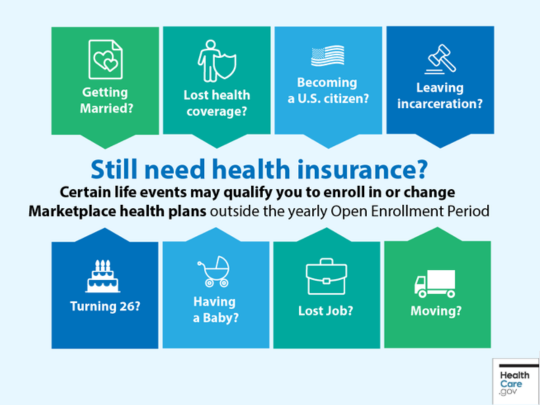Understanding Open Enrollment and Its Closure
The ACA Open Enrollment Period is the annual window when individuals can enroll in or modify health insurance plans through the federal Marketplace (HealthCare.gov) or state-based exchanges, such as Covered California or New York State of Health. For 2025 coverage, this period ended on January 15, 2025, in most states, with some state-based exchanges like New Jersey and California extending deadlines to January 31, 2025. After this date, you generally cannot enroll in a Marketplace plan unless you qualify for an exception.
Missing Open Enrollment can feel daunting, especially with rising health care costs. However, 2025 offers multiple avenues to secure coverage, thanks to expanded ACA subsidies, flexible enrollment options, and alternative plans. Below, we’ll detail each option, eligibility criteria, and steps to take, ensuring you’re equipped to make informed decisions.
Option 1: Special Enrollment Period (SEP)
What Is an SEP?
A Special Enrollment Period allows you to enroll in a Marketplace plan outside Open Enrollment if you experience a qualifying life event. SEPs typically last 60 days from the date of the event, giving you a window to apply for coverage through HealthCare.gov or your state’s Marketplace.
Qualifying Life Events
Common events that trigger an SEP in 2025 include:
- Loss of Other Coverage: Losing employer-sponsored insurance, COBRA, or a Marketplace plan (e.g., due to job loss, divorce, or aging off a parent’s plan at 26).
- Changes in Household: Marriage, divorce, birth or adoption of a child, or death of a spouse.
- Changes in Residence: Moving to a new state or ZIP code with different plan options.
- Other Triggers: Becoming a U.S. citizen, leaving incarceration, or gaining eligibility for ACA subsidies due to income changes.
- Special Circumstances: Errors in enrollment, domestic violence, or natural disasters affecting your ability to enroll.
New in 2025: DACA recipients are now eligible for ACA Marketplace plans and subsidies, potentially qualifying for an SEP if they experience a life event.
How to Apply for an SEP
- Verify Eligibility: Visit HealthCare.gov or your state’s Marketplace website to confirm your qualifying event. You may need documentation, such as a marriage certificate or proof of job loss.
- Submit an Application: Log in to your Marketplace account or create one. Report your life event and select a plan within 60 days.
- Provide Documentation: Upload required documents (e.g., termination letter from an employer) to verify your eligibility.
- Choose a Plan: Select from available plans, which may include bronze, silver, gold, or platinum tiers, depending on your needs and budget.
- Pay Your Premium: Coverage begins after your first premium payment, often the first day of the following month.
Example: If you lose your job on February 15, 2025, and with it your employer-sponsored insurance, you have until April 16, 2025, to apply for an SEP. You could enroll in a silver plan with subsidies, potentially paying as little as $10/month, thanks to enhanced 2025 tax credits.
Tip: Contact a certified enrollment counselor through your state’s Marketplace or call HealthCare.gov (1-800-318-2596) for free assistance.
Option 2: Medicaid and CHIP
Overview
Medicaid and the Children’s Health Insurance Program (CHIP) provide free or low-cost coverage for eligible low-income individuals, families, and children. Unlike ACA Marketplace plans, these programs allow enrollment year-round, making them a critical option after Open Enrollment.
Eligibility
Eligibility varies by state but generally includes:
- Income: Households with incomes up to 138% of the federal poverty level (FPL) in states that expanded Medicaid (e.g., $20,783 for an individual in 2025). CHIP covers children in families with incomes up to 200%-400% of FPL, depending on the state.
- Demographics: Pregnant women, children, parents, seniors, and people with disabilities often qualify.
- Other Factors: Residency, citizenship status, or immigration status (e.g., DACA recipients may qualify in some states).
2025 Update: Enhanced ACA subsidies and state-specific expansions mean more people may qualify for Medicaid or CHIP, especially in states like New York and Pennsylvania.
Benefits
- Comprehensive coverage, including doctor visits, hospital stays, prescriptions, and preventive care.
- Low or no premiums and copays.
- Year-round enrollment, no SEP required.
How to Apply
- Check Eligibility: Use HealthCare.gov’s screening tool or visit your state’s Medicaid website.
- Apply: Submit an application through your state’s Medicaid agency, HealthCare.gov, or in person at a local office. Some states, like New York, allow enrollment through their state Marketplace (nystateofhealth.ny.gov).
- Provide Documentation: Submit proof of income, residency, and household size.
- Await Approval: Processing times vary, but coverage may start immediately upon approval.
Example: A family of four in California with an income of $36,000 qualifies for Medi-Cal (California’s Medicaid program). They enroll in March 2025, gaining free coverage for doctor visits, vaccinations, and dental care for their children.
Tip: If your income is too high for Medicaid but low enough for subsidies, you may qualify for a heavily subsidized Marketplace plan during an SEP.

Option 3: Short-Term Health Insurance
Overview
Short-term health insurance plans are temporary policies that provide coverage for gaps in insurance, often lasting up to 4 months in 2025 (with some states allowing renewals up to 12 months). These plans are not ACA-compliant, meaning they don’t cover all essential health benefits, but they’re a viable option for healthy individuals needing immediate coverage.
Eligibility
- Available to most people, regardless of income or life events.
- Often requires health screenings; pre-existing conditions may not be covered.
Pros and Cons
Pros:
- Lower premiums than ACA plans (e.g., $50-$200/month for an individual).
- Quick enrollment, with coverage starting as soon as the next day.
- Flexible terms, ideal for bridging gaps until the next Open Enrollment (November 1, 2025).
Cons:
- Limited coverage: May exclude maternity care, mental health, or prescription drugs.
- No subsidies: You pay the full premium.
- Potential for high out-of-pocket costs if serious health issues arise.
- Not available in all states (e.g., banned in California, New York).
How to Apply
- Research Providers: Compare plans from insurers like UnitedHealthcare or Pivot Health, available through brokers or websites like eHealthInsurance.com.
- Check State Rules: Confirm short-term plans are legal in your state and review duration limits.
- Apply Directly: Complete a health questionnaire and select a plan. No Marketplace account is needed.
- Pay and Activate: Coverage begins after payment, often within 24 hours.
Example: A 30-year-old freelancer in Texas misses Open Enrollment and buys a 3-month short-term plan for $100/month. It covers doctor visits and emergencies but excludes pre-existing conditions like asthma, serving as a stopgap until November 2025.
Tip: Use short-term plans cautiously and read the fine print to understand exclusions. Consider them only if you’re healthy and don’t qualify for an SEP or Medicaid.
Option 4: Other Insurance Options
Employer-Sponsored Insurance
If you start a new job or gain access to a spouse’s employer plan, you may enroll within 30-60 days of eligibility, regardless of Open Enrollment. Contact your HR department to explore options.
COBRA
If you lose employer-sponsored coverage, COBRA allows you to continue your plan for up to 18-36 months. However, you pay the full premium (often $500-$2,000/month), making it costly. COBRA may trigger an SEP for a Marketplace plan, which could be more affordable with subsidies.
Medicare
For those 65 or older, or with certain disabilities, Medicare enrollment is separate from ACA Open Enrollment. The Medicare Open Enrollment Period (October 15–December 7, 2024, for 2025 coverage) allows changes to Advantage Plans or Part D. Outside this period, Initial Enrollment or Special Enrollment Periods may apply for new Medicare eligibles.
Catastrophic Plans
Available to those under 30 or with a hardship exemption, catastrophic plans offer low premiums but high deductibles. Enrollment requires an SEP or Open Enrollment, but they’re worth considering if you’re young and healthy.
Health Sharing Plans
Non-insurance options like Medi-Share involve members pooling funds to cover medical expenses. These plans are not regulated, have limited coverage, and may not meet ACA requirements, but they’re affordable for some. Research carefully, as they may not cover pre-existing conditions or major procedures.
Option 5: State-Specific Programs
Some states offer year-round enrollment for state-specific plans:
- New York: The Essential Plan and Child Health Plus allow enrollment anytime for eligible low-income residents.
- Pennsylvania: Pennie, the state’s Marketplace, connects residents to Medicaid and CHIP year-round.
- New Jersey: GetCoveredNJ offers extended SEPs and Medicaid enrollment options.
Check your state’s health insurance website for unique programs or extended deadlines.
Strategies to Stay Covered in 2025
- Act Quickly: If you experience a qualifying life event, apply for an SEP within 60 days to avoid coverage gaps.
- Explore Subsidies: Enhanced ACA tax credits in 2025 mean 4 in 5 HealthCare.gov customers can find plans for $10 or less per month. Even if you don’t qualify for Medicaid, subsidies can make Marketplace plans affordable.
- Seek Assistance: Work with a certified enrollment counselor or navigator for free guidance. Find local help through HealthCare.gov or your state’s Marketplace.
- Plan for November 2025: Mark your calendar for the next Open Enrollment (November 1, 2025–January 15, 2026) to secure a comprehensive ACA plan.
- Consider Temporary Coverage: Use short-term plans or health sharing as a bridge, but prioritize ACA-compliant plans for long-term security.
- Monitor Income: If your income drops, recheck Medicaid or CHIP eligibility, as you may qualify year-round.
Potential Challenges and Solutions
- Limited SEP Eligibility: If you don’t have a qualifying event, your options are restricted to Medicaid, short-term plans, or state programs. Solution: Explore health sharing plans or save for out-of-pocket costs until November 2025.
- High COBRA Costs: COBRA is expensive without employer subsidies. Solution: Use COBRA to trigger an SEP and switch to a subsidized Marketplace plan.
- State Restrictions: Some states ban short-term plans or have strict Medicaid rules. Solution: Check state-specific programs or move to an SEP-eligible event (e.g., marriage).
- Confusion Over Options: Health insurance is complex. Solution: Use free resources like HealthCare.gov’s chatbot or call 1-800-318-2596 for clarity.
Sentiment in 2025
Posts on X reflect ongoing awareness of post-Open Enrollment options:
- @GetCoveredNJ emphasizes that major life changes (e.g., marriage, job loss) can qualify you for an SEP, directing users to GetCoveredNJ for enrollment.
- @AccessHealthCT outlines four easy steps to enroll during an SEP, highlighting accessibility for Connecticut residents. These sentiments underscore the importance of SEPs and state programs, but always verify eligibility through official channels like HealthCare.gov.

Final Thoughts
Missing the 2025 Open Enrollment Period doesn’t mean you’re without health care options. Special Enrollment Periods offer a lifeline for those with qualifying life events, while Medicaid and CHIP provide year-round coverage for low-income individuals. Short-term plans, COBRA, Medicare, and state-specific programs like New York’s Essential Plan fill additional gaps, ensuring you can find coverage that fits your needs and budget. By acting quickly, leveraging subsidies, and seeking expert guidance, you can secure affordable, comprehensive health insurance in 2025.



